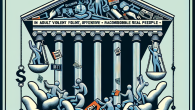
The Swiss Franc and Safe-Haven Mythology in Currency Markets
The Greenback’s Grip: Will the US Dollar Maintain Its Global Dominance in 2024?
Ah, the mighty dollar—the economic Excalibur of the modern age, wielded not by kings and queens, but by central banks, traders, and sovereign states. For decades, the United States dollar (USD) has worn the crown of global finance, serving as the world’s primary reserve currency. But in 2024, with geopolitical realignments, shifting trade landscapes, and central bank experimentation, a pressing question emerges: can the greenback maintain its dominance, or is change on the horizon?
As your well-groomed guide to global macroeconomics—Dr. Alistair P. Whitmore at your service—I shall navigate you through the crosscurrents underpinning the dollar’s throne. Expect measured prose, economic gravitas, and perhaps the occasional metaphorical flourish.
Why the Dollar Dominates: A Historical Prelude
Since the Bretton Woods Agreement of 1944, the USD has stood as the world’s preferred reserve currency, replacing the British Pound in a post-World War II economic reshuffle. This status was not simply by virtue of military victory, but due to deep, liquid capital markets, stable governance, and the sheer scale of the U.S. economy.
Central banks, notably those in Europe and Asia, continue to hold the bulk of their reserves in dollars. Trade invoices—especially for oil, commodities, and most internationally-traded goods—are predominantly dollar-denominated. This structure has fueled what economists call the “exorbitant privilege” of the U.S.: the ability to borrow cheaply while the world demands its currency.
Headwinds in 2024: Has the World Had Enough of the Greenback?
Yet the winds do change, and even the firmest flagpoles tremble. In 2024, several key trends challenge the dollar’s global supremacy:
1. Geopolitical Fragmentation and the Rise of Bilateral Trade
The economic bromance between the West and East is losing its sheen. The U.S.-China rivalry has led Beijing and several BRICS nations to explore alternate invoicing currencies. Russia and China now settle much of their bilateral trade in yuan and rubles. India pays for some imports in rupees. These maneuvers hint at a global system no longer guaranteed to default to the dollar.
2. Central Bank Diversification
Data from the International Monetary Fund (IMF) shows that the dollar’s share of global reserves has decreased gradually—from over 70% in 1999 to around 58% in 2023. While not a collapse, the direction is clear. Central banks are diversifying into euros, yen, and increasingly, the Chinese yuan.
3. The Digital Currency Question
Central Bank Digital Currencies (CBDCs) are on the rise. China’s digital yuan experiment is leading the charge, with over 260 million users as of late 2023. The potential for CBDCs to bypass the SWIFT payments system and settle cross-border transactions without the USD is no longer theoretical. The digital dollar, in contrast, remains at the conceptual stage within the Federal Reserve.
4. Fiscal Volatility and Political Dysfunction
Let us not pretend the U.S. economy is immune to internal decay. Repeated debt-ceiling dramas, widening fiscal deficits, and polarized governance have cast shadows over the dollar’s long-term value. While still considered a “safe haven,” cracks in investor confidence are emerging—albeit subtly.
Why the Dollar Isn’t Done Just Yet
Despite these challenges, a burial for the greenback appears premature, if not melodramatic. Here’s why the dollar’s reign may persist through 2024 and beyond:
1. Network Effects and Inertia
Changing a global financial system is like steering a cargo ship in a bathtub. The infrastructure supporting dollar-based trade is entrenched: from SWIFT to global banking norms, to pricing mechanisms in commodities. Transitioning away is costly and slow.
2. Trust and Transparency Still Matter
Say what you will about the United States’ internal squabbles, but it remains one of the most transparent and legally reliable jurisdictions on Earth. Investors crave stable rule-of-law environments. In contrast, alternatives like the yuan are constrained by Chinese capital controls and opaque monetary policy frameworks.
3. Liquidity and Safe-Haven Demand
When global markets lurch into chaos, investors don’t run to the rupee or the real—they seek out U.S. Treasuries. In times of uncertainty, the dollar remains a port in the storm, with deep secondary markets and unmatched liquidity. This is unlikely to change quickly.
4. The Dollar as a Benchmark, Not Just a Currency
Let’s not forget: the dollar is not simply a means of exchange. It’s the benchmark for global finance. Everything from oil prices to emerging market debt to airline leases is quoted in USD. Its value affects global inflation, interest rates, and capital flows.
What Could Truly Undermine USD Dominance?
While we’ve established that erosion is gradual, it’s important to identify scenarios that could genuinely rattle the foundations of dollar supremacy:
- Accelerated CBDC adoption—If several major economies launch interoperable digital currencies, bypassing SWIFT and dollar settlement, demand for USD reserves could drop.
- Currency blocs—Should BRICS nations formalize a trade settlement mechanism in local or shared currencies, global dependency on the dollar may slowly wane.
- Loss of geopolitical trust—A significant breakdown in U.S. governance or a serious downgrade in its debt could cause a flight to alternatives like gold, Bitcoin, or even the euro.
Conclusion: The Throne May Shake, But It Hasn’t Fallen
To paraphrase Mark Twain, rumors of the dollar’s death have been greatly exaggerated. While there are credible arguments against the dollar’s monopolistic grip, no rival meets the trifecta of liquidity, transparency, and global trust—the attributes necessary to replace it.
The dollar’s dominance may decline in percentages, but not in principle—at least not yet. As of 2024, it remains the anchor of the global financial system. However, vigilance is key. If the United States wishes to retain its monetary throne, it must also preserve the economic virtues that placed it there: sound fiscal policy, legal stability, and global cooperation.
After all, in global finance—as in life—dominance is not a right, but a responsibility.
For more insights into global finance and macroeconomic trends, visit our About Us or Contact Us pages. We always welcome readers with refined economic curiosities.









Leave a Reply